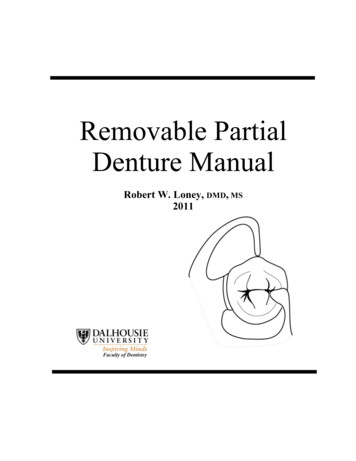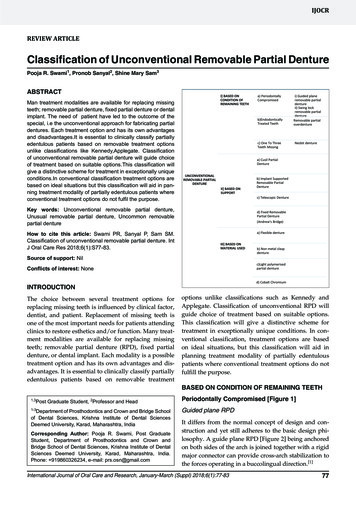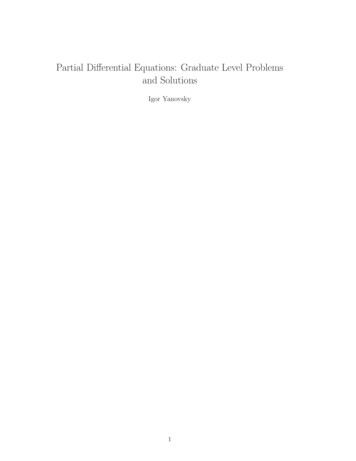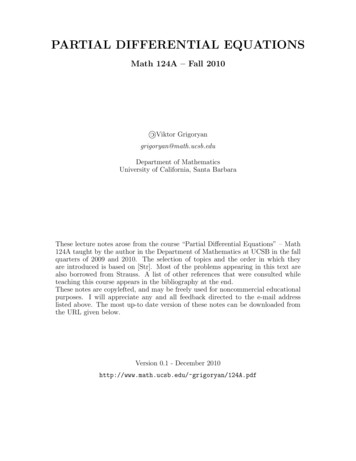
Transcription
An IntroductiontoApplied Partial Differential EquationsMarek Z. ElżanowskiDepartment of Mathematics and StatisticsPortland State University
ContentsPrefaceixChapter 1. Boundary Value Problems11.1. Elastic Bar11.2. The Green’s Function51.3. Minimum Principle131.4. Elastic Beam18Chapter 2. The Diffusion Equation232.1. Heat Conduction232.2. Separation of Variables262.3. Uniqueness of Solutions332.4. Fundamental Solutions342.5. Burgers’ Equation41Chapter 3. Laplace’s Equation453.1. Physical Interpretation453.2. Separation of Variables463.3. The Green’s Function523.4. Minimum Principles56Chapter 4. Vibrations of One-Dimensional Medium614.1. The Wave Equation614.2. d’Alembert’s Solution634.3. Nonlinear Waves704.4. Classification of Linear Partial Differential Equations75Appendix A. Normed and Inner Product Vector SpacesA.1. Inner Product Vector Spaces7777vii
viiiCONTENTSA.2. Normed Vector Spaces81A.3. Complex Vector Spaces84Appendix B. Fourier Theory87B.1. Fourier Series87B.2. Differentiation and Integration of Fourier Series92B.3. Complex Fourier Series and the Delta Function96B.4. Convergence of the Fourier Series99B.5. Fourier Transform109Bibliography117Index119
PrefaceThese notes are written for a one-quarter (pilot) course in elementary partialdifferential equations. It is assumed that the student has a good background incalculus, vector calculus, and ordinary differential equations. No prior knowledgeof any partial differential equations concepts is assumed, nor any required. Somefamiliarity with the elementary theory of inner vector spaces would be an assetbut is not expected. In fact, most of the needed concepts and facts are reviewedin the Appendix.The main objective of this presentation is to introduce basic analytic techniques useful in solving most fundamental partial differential equations that arisein the physical and engineering sciences. The emphasis are placed on the formulation of a physical problem, deriving explicit analytic results, and on thediscussion of properties of solutions. Although the proofs are usually omitted,the underlying mathematical concepts are explained and discussed at length.The notes are divided into several short chapters and the Appendix. In Chapter 1 we discuss solutions to the equilibrium equations of one-dimensional continuous systems. These are formulated as boundary-value problems for scalarordinary differential equations. The Green’s function technique and the minimum principle are discussed. Chapter 2 deals with the diffusion equation, inparticular, the heat propagation equation. In the last section of this chapterwe briefly discuss the Burgers’ equation. Solutions to a variety of homogeneousand inhomogeneous initial-boundary-value problems are derived using such analytic techniques as the separation of variables method and the concept of thefundamental solution. Laplace’s equation and the wave equation are dealt within Chapter 3 and 4, respectively. Once again, the separation of variables andthe Fourier series methods are utilized. The Green’s function technique is alsoresearched. d’Alembert’s solution of the wave equation is derived. An elementaryix
xPREFACEdiscussion on the propagation of one-dimensional non-linear waves is presented.The Appendix consists of two parts. In the first part, the elements of the theoryof inner product vector spaces are reviewed. The second part contains the presentation of the theory of Fourier series, and a short section on Fourier integrals.Although the notes are as self contained as possible, students may find useful to consult some other texts like for example [Bleecker and Csordas],[Boyce and DiPrima], [Keane], [Knobel], and [Davis], among others.Portland. Oregon, June 2003
CHAPTER 1Boundary Value ProblemsIn this introductory chapter we discuss the equilibrium equations of onedimensional continuous systems. These are formulated as boundary value problems for scalar ordinary differential equations. We concentrate on deriving theexact analytical formulae for the solutions of these equations giving us the necessary inside into the physical processes we model.1.1. Elastic BarBy a bar we mean a finite length one-dimensional continuum that can onlybe stretched or contracted (deformed, in short) in the longitudinal direction, andis not allowed to bend in a transverse direction. Given a point x on a bar wemeasure its deformation from the reference position by the displacement u(x).That is, a material point which was originally at the position x has been movedto the position x u(x). We adopt the convention that u(x) 0 means that thematerial is stretched out, while u(x) 0 describes a contraction by the amount u(x). We also assume that the left (top) end of the bar is fixed, i.e., u(0) 0.The internal forces experienced by the bar, known as stress, do not necessarilydepend on how much the bar is stretched as a whole but rather on how muchone material point is moved relative to the neighboring points. This relativeamount of elongation is measured by the strain. Consider two material points(particles) occupying in the reference configuration positions x and x 4x, respectively, where 4x is the small section of the bar. When the bar experiencesthe displacement u the section of length 4x gets stretched to the new length[x 4x u(x 4x)] [x u(x)] 4x [u(x 4x) u(x)] .The relative elongation of the segment 4x is1(1.1.1)
21. BOUNDARY VALUE PROBLEMSu(x 4x) u(x).4x(1.1.2)Shrinking the segment of the bar to a point, we obtain the dimensionless strainmeasure at the position xu(x 4x) u(x)du .4x 04xdxε(x) lim(1.1.3)The material the bar is made of is defined by the constitutive relation for thestress. This constitutive law tells how the stress depends on the strain when thebar undergoes a deformation. Here we shall only consider a linear relation which,in fact, approximates the real case quite adequately as long as the strain is small.If s(x) denotes the stress exerted on a material point which was at the referenceposition x, we postulates(x) c(x)ε(x),(1.1.4)where c(x) measures the stiffness of the bar at material point x. If the bar ishomogeneous c(x) c is constant.We also postulate that the internal stresses of the deformed bar balance theexternal forces imposed. That is, if f (x) denotes the external force applied at x,we assume thats(x 4x) s(x)1 4x4xZx 4xf (s)ds 0(1.1.5)xper unit length of a segment of the bar between positions x and x 4x, wheref (x) 0 if the bar gets stretched. Invoking the Mean Value Theorem and takingthe limit of the left hand side of (1.1.5) as 4x 0 we obtain thatds(1.1.6)dxeverywhere along the bar. Substituting the constitutive law (1.1.4) into thef equation of balance of forces (1.1.6) and using the definition of the strain function (1.1.3) we obtain the equation of equilibrium
1.1. ELASTIC BARd dxµ¶duc(x) f (x),dx30 x l(1.1.7)for the linearly elastic bar of length (in the reference configuration) l. This is asecond-order ordinary differential equation for the displacement u(x). Its generalsolution depends on two arbitrary constants. They can be uniquely determinedby the boundary conditions at the ends of the bar. For example, letu(0) 0,s(l) c(l)ε(l) c(l)u0 (l) 0(1.1.8)as the left(top) end of the bar is fixed and the other end is assumed to be free(stress free).Example 1.1. Consider a homogeneous bar of unit length subjected to auniform force, e.g., a bar hanging from a celling and deforming under its ownweight. The equilibrium equation (1.1.7) takes the formd2 u mg,(1.1.9)dx2where m denotes the mass of the bar and g is the gravitation constant. This is a clinear second order equation solution of which ismg 2x ax b.(1.1.10)2cThe arbitrary integration constants a and b can be determined from the boundaryu(x) conditions (1.1.8). Namely,mg a 0.2cThe corresponding unique solution yields the parabolic displacementu(0) b 0,u0 (1) mgu(x) cµx2x 2(1.1.11)¶(1.1.12)and the linear strainε(x) mg(1 x).c(1.1.13)
41. BOUNDARY VALUE PROBLEMSNote that the displacement is maximum at the bottom free end of the bar whilestrain, and so the stress, are maximum at the fixed end. Note also that as theboundary condition at the free end determines both the strain and the stress atthat end the equilibrium equation can be first solved uniquely for stress withoutcalculating the displacement. Such a mechanical configuration is known as statically determinate. This is in contrast with the problem in which the displacementis prescribed at both ends of the beam, e.g.,u(0) 0,u(1) r.(1.1.14)The general solution to the equilibrium equation (1.1.7) takes the same parabolicform (1.1.10). The unique solution satisfying the boundary conditions (1.1.14)yieldsu(x) mg(x x2 ) rx.2c(1.1.15)Once the displacement is available we can calculate the stress field1s(x) mg( x) r.2(1.1.16)However, unlike as in case of the bar with the free end, the stress cannot bedetermined without knowing the displacement. The equilibrium equation (1.1.7)can be re-written in terms of stress ds mg,dx(1.1.17)but the integration constant in the general stress solution s(x) mgx acannot be determined as there is no stress boundary condition available. Such amechanical configuration is called statically indeterminate.Remark 1.2. Our equation (1.1.7) not only describes the mechanical equilibrium of an elastic bar but it models also some other physical systems. Forexample, this is the thermal equilibrium equation of a bar subjected to an external heat source. Indeed, if u(x) represents the temperature at the position x,
1.2. THE GREEN’S FUNCTION5c(x) is the thermal conductivity of the material at x, and f (x) denotes the external heat source, then the energy conservation law yields (1.1.7)1. A boundarycondition u(l) r corresponds to the situation when an end is kept at a fixedtemperature. u0 (l) 0, on the other hand, describes a thermally insulated end.1.2. The Green’s FunctionThe Green’s function method is one of the most important approaches to thesolution of boundary value problems. It relies on the superposition principle forinhomogeneous linear equations. Namely, it builds the general solution out of thesolutions to a very particular set of concentrated inhomogeneities.The superposition principle for a linear homogeneous differential equationstates that if u1 (x) and u2 (x) are solutions then every linear combination αu1 (x) βu2 (x) is also a solution, where α and β are arbitrary real numbers. Moreover,if the functions f1 , . . . , fn represent the inhomogeneities (forcing terms) of thelinear differential equationK[u] fi ,i 1, . . . , n,(1.2.1)where K[u] denotes the differential operator (the left hand side of an equation,e.g., K[u] cu00 ), and if u1 (x), . . . , un (x) are the corresponding solutions thenthe linear superposition α1 u1 (x) α2 u2 (x) . . . αn un (x) is a solution ofK[u] α1 f1 α2 f2 . . . αn fn(1.2.2)for any choice of the constants α1 , . . . , αn .Our objective here is to use this superposition principle to solve the boundaryvalue problem for a homogeneous elastic bar. To be able to do this we must solvefirst the boundary value problem with the unit impulse as a source term. Sucha solution is called the Green’s function and it will be used later to construct asolution to the corresponding boundary value problem with an arbitrary forcingterm. First, we shall characterize a unit impulse (a point force) concentrated ata point of the bar by introducing the notion of the delta function.1Seethe derivation of the heat conduction equation (2.1.6) in the next chapter.
61. BOUNDARY VALUE PROBLEMSThe Delta Function.As the impulse is to be concentrated solely at a single point, say y, the deltafunction δy (x) should be such thatδy (x) 0,for x 6 y.(1.2.3)Moreover, as we would like the strength of the impulse to be one, and there is noother external force applied, we require thatZlδy (x)dx 1,as long as 0 y l.(1.2.4)0Looking at both conditions δy (x) must satisfy one realizes quickly that there isno such function.The mathematically correct definition of such a generalized function, whichcan for example be found in [Ziemer] (see also [Lang]), is well beyond the scopeof these notes. It relies on the assumption that for any bounded continuousfunction u(x)Zlδy (x)u(x)dx u(y),if 0 y l.(1.2.5)0Here, we will present the ”approximate” definition of the delta function whichregards δy (x), considered over the infinite domain ( , ), as the limit of asequence of continuous functions. To this end, letfn (x; y) nπ(1 n2 (x y)2 ).(1.2.6)These functions are such thatZ 1 1,fn (x; y)dx arctan(nx) π (1.2.7)andlim fn (x; y) n 0,x 6 0 , x 0(1.2.8)
1.2. THE GREEN’S FUNCTION7pointwise, but not uniformly2. Hence, we identify δy (x) with the limitlim fn (x; y) δy (x).n (1.2.9)Note, however, that this construction of the delta function should only be viewedas a visualization of such a generalized function, and not as its correct mathematical definition. Indeed, within the context of the Riemann’s integration theoryZZ 1 limfn (x; y)dx 6 n lim fn (x; y)dx 0 n (1.2.10)as the limit of the integral is not necessarily the integral of the limit. On theother hand, this can be made to work if we adopt a somewhat different definitionof the limit. This can allow us to justify the formula (1.2.5) as the limit of theapproximating integrals. In these notes we will use both definitions of the deltafunction interchangeably.Let us consider now the calculus of the delta function, that is, its integrationand differentiation. Firstly, assuming that a y and using the definition (1.2.5)we obtain thatZxa 0, a x y,δy (s)ds σy (x) 1, x y a,(1.2.11)is the step function. This is a function which is continuous everywhere except atx y, where its is not defined and experiences a jump discontinuity (1.2.15). Thevalue of the step function at x y is often left undefined. Motivated by Fouriertheory3 we set σy (y) 21 . Interestingly enough we obtain the same result usingthe characterization of the delta function as the limit of the sequence fn (x; y).Indeed, ifZxgn (x) fn (t, 0)dt then2SeeDefinition B.18.3SeeTheorem B.4.11arctan(nx) ,π2(1.2.12)
81. BOUNDARY VALUE PROBLEMSlim gn (x) σ(x) σ0 (x)(1.2.13)n pointwise. In tern, the Fundamental Theorem of Calculus allows us to identifythe derivative of the step function with the delta function;dσy (x) δy (x).(1.2.14)dxIn fact, this enables us to differentiate any discontinuous function having finitejump discontinuities at isolated points. Suppose the function f (x) is differentiableeverywhere except at a single point y at which it has a jump discontinuity[f (y)] f (y) f (y) lim f (x) lim f (x).(1.2.15)f (x) g(x) [f ]σy (x),(1.2.16)x yx yWe can writewhere g(x) f (x) [f ]σy (x) is a continuous function, but is not necessarilydifferentiable at y. Therefore, g 0 (x),x 6 y0f (x) [f ]δ (x), x y.y(1.2.17)f 0 (x) g 0 (x) [f ]δy (x).(1.2.18)In short, we writeExample 1.3. Consider the function x 1, x 0, f (x) 0,0 x 1, x2 ,x 1.(1.2.19)It has two jump discontinuities: [f ] 1 at x 0, and [f ] 1 at x 1.Utilizing the construction (1.2.16) one gets that
1.2. THE GREEN’S FUNCTION9 x 1, x 0, g(x) f (x) σ(x) σ1 (x) 1,0 x 1, x2 ,x 1andf 0 (x) g 0 (x) δ(x) δ1 (x) δ(x) δ1 (x) 1, x 0, 0, 2x,0 x 1,x 1.To find the derivative δy0 (x) of the delta function let us determine its effect ona function u(x) by looking at the limiting integralZ limn Z dfn (x; 0) u(x)dx lim fn (x; 0)u(x) limfn (x; 0)u0 (x)dxn n dx (1.2.20)Z δ0 (x)u0 (x)dx u0 (0), where the integration by parts was used and where the function u(x) is assumecontinuously differentiable and bounded to guarantee thatlim fn (x; 0)u(x) 0.n (1.2.21)Hence, we postulate that δy0 (x) is a generalized function such thatZl0δy0 (x)u(x)dx u0 (y).(1.2.22)Note that this definition of the derivative of the delta function is compatible withthe formal integration by parts procedureZl0δy0 (x)u(x)dx l Z l δy (x)u0 (x)dx u0 (y). δy (x)u(x) 0(1.2.23)0Note also that one may view the derivative δy0 (x) as the limit of the sequence ofderivatives of the ”approximating” functions fn (x; 0). That is,
101. BOUNDARY VALUE PROBLEMSdfn (x; 0) 2n3 π lim.(1.2.24)n n π(1 n2 x2 )2dxThese are interesting rational functions. First of all, it easy to see that theδ00 (x) limsequence converges pointwise, but not uniformly, to 0. Also, elementary calculations revile, that the graphs of the functions consist of two increasingly concen1trated symmetrically positioned at x n spikes, and that the amplitudes of3these spikes approach , respectively, as n .The Green’s Function.Once we have familiarized ourselves with the delta function we may try now tosolve the boundary value problem for a homogeneous elastic bar with the deltafunction (unit impulse) as its source term. As we have explained earlier, themain idea behind this approach is to use the superposition principle to obtainthe solution for a general external force by putting together the solutions to theimpulse problems.Consider a linearly elastic bar of the reference length l subjected to a unitpoint force δy (x) applied at position 0 y l. The equation governing such asystem (1.1.7) takes the formd dxµ¶duc(x) δy (x),dx0 x l.(1.2.25)The solution G(x; y) to the boundary value problem associated with (1.2.25) iscalled the Green’s function of the problem. To illustrate how such a solutioncomes about let us consider the following homogeneous boundary value problem u00 δy (x),u(0) u(1) 0,(1.2.26)for a bar of length l 1 and the stiffness c 1, where 0 y l. Integrating theequation twice we obtain that ax b,x y,u(x) (x y) ax b, x y.Taking into consideration the boundary conditions we have that(1.2.27)
1.2. THE GREEN’S FUNCTIONu(0) b 0,11and u(1) (1 y) a b 0.This implies that b 0, a 1 y, and the Green’s function of this boundaryvalue problem is x(1 y), x y,G(x; y) y(1 x), x y.(1.2.28)This is a continuous, piecewise differentiable function. Its first derivative experiences a jump of magnitude 1 at x y. In fact, this is a piecewise affine functionas its graph consists of straight line segments only. Note also that the Green’sfunction, viewed as a function of two variables, is symmetric in x and y. Thissymmetry has an interesting physical interpretation that the deformation of thebar measured at position x due to the point force applied at position y is exactlythe same as the deformation of the bar at position y due to the concentratedforce being applied at position x.Once we have the Green’s function available we can solve the general inhomogeneous problem u00 f (x),u(0) u(1) 0,(1.2.29)by the linear superposition method. To be able to do this we need first to express the forcing term f (x) as a superposition of point forces (impulses) distributed throughout the bar. The delta function comes handy again as, accordingto (1.2.5), it enables us to write the external forcing term asZ1f (x) f (y)δx (y)dy.(1.2.30)0One may interpret the external source f as the superposition of an infinitelymany point sources f (y)δx (y) of the amplitude f (y) applied throughout the barat 0 x l. Re-writing the differential equation (1.2.29) asZ100 u f (y)δx (y)dy0renders the solution u(x) as a linear combination(1.2.31)
121. BOUNDARY VALUE PROBLEMSZ1u(x) f (y)G(x; y)dy(1.2.32)0of solutions to the unit impulse problems. We can verify by direct computationthat the formula (1.2.32) gives us the correct answer to the boundary value problem (1.2.29). Indeed, using the formula for the Green’s function (1.2.28) we maywrite the solution of (1.2.29) asZZxu(x) 1(1 x)yf (y)dy 0x(1 y)f (y)dy.(1.2.33)xDifferentiating it once gives usZZ10u (x) 1yf (y)dy 0f (y)dy.xDifferentiating it once again shows thatu00 (x) f (x).For a particular forcing term f (x) it may be easier to solve the problem directlyrather than by using the corresponding Green’s function. However, the advantageof the Green’s function method is that it provides the general framework for anyand all inhomogeneous equations with the homogeneous boundary conditions.The case of the inhomogeneous boundary value problem will be discussed in thenext chapter.Example 1.4. Consider now a different boundary value problem for a uniformbar of length l. Namely, cu00 (x) δy (x),u(0) 0,u0 (l) 0,(1.2.34)where c denotes the elastic constant. This problem models the deformation of thebar with one end fixed and the other end free. Integrating this equation twice,we find the general solution1u(x) ρ(x y) ax b,cwhere
1.3. MINIMUM PRINCIPLE13 x y, x y,ρ(x y) 0,x y,(1.2.35)is called the (first order) ramp function. Utilizing the given boundary conditionswe find the Green’s function for this problem as x/c, x y,G(x; y) y/c, x y.(1.2.36)Again, this function is symmetric and affine. Also, it is continuous but notdifferentiable at the point of application of the external force x y, where itsderivative experiences a 1/c magnitude jump. The formula for the solution ofthe corresponding boundary value problem for the inhomogeneous equation cu00 (x) f (x),u(0) 0,u0 (l) 0,(1.2.37)takes the formZlu(x) 01G(x; y)f (y)dy c·ZZxyf (y)dy .xf (y)dy 0 lx1.3. Minimum PrincipleIn this section we shall discuss how the solution to a boundary value problemis a unique minimizer of the corresponding ”energy” functional. This minimization property proves to be particularly significant for the design of numericaltechniques such as the finite elements method.We start by taking a short detour to discuss the concept of an adjoint of alinear operator on an inner product vector space 4 . Let L : U W denote a linear operator from the inner product vector space U into another (not necessarilydifferent) inner product vector space W . An adjoint of the linear operator L isthe operator L? : W U such thathL[u]; wiW hu; L? [u]iU4Thefor all u U,w W,fundamentals of Inner Product Vector Spaces are reviewed in Appendix A.(1.3.1)
141. BOUNDARY VALUE PROBLEMSwhere the inner products are evaluated on the respective spaces as signified bythe corresponding subscripts. Note that if U W Rn , with the standard dotproduct, and the operator L is represented by a n n matrix A, then the adjointL? can be identified with the transpose AT .In the context of an equilibrium equation for a one-dimensional continuum themain linear operator is the derivative D[u] du/dx. It operates on the space ofall possible displacements U into the space of possible strains W . To evaluate itsadjoint we impose on both vector spaces the same standard L2 inner product,i.e.,ZZbhu; ũiU u(x)ũ(x)dx,bhw; w̃iW aw(x)w̃(x)dx.(1.3.2)aAccording to (1.3.1) the adjoint D? of the operator D must satisfyhD[u]; wiWdu h ; wiW dxZbaduw(x)dx hu; D? [w]iU dxZbu(x)D? [w](x)dx,a(1.3.3)for all u U and w W . Note, however, that the integration by part yieldsZbduhD[u]; wiW w(x)dx [u(b)w(b) u(a)w(a)] a dxdw [u(b)w(b) u(a)w(a)] hu;iU .dxThis suggests thatZbu(x)a¶?dd ,dxdxprovided the functions u U and w W are such thatdwdx (1.3.4)dxµ[u(b)w(b) u(a)w(a)] 0.(1.3.5)(1.3.6)This will be possible if we impose suitable boundary conditions. In other words,if we define the vector spaceU {u(x) C 1 [a, b] :u(a) u(b) 0}(1.3.7)
1.3. MINIMUM PRINCIPLE15as containing all continuously differentiable functions (displacements) vanishingat the boundary, and restrict the operator D to U , the definition of the adjoint (1.3.5) will hold. Obviously, these are not the only boundary conditionsguaranteeing (1.3.5). The other possible choice is the space of displacementsU {u(x) C 1 [a, b] :u0 (a) u0 (b) 0}Yet another possibility is the strain spaceW {w(x) C 1 [a, b] :w(a) w(b) 0}.This is the case when due to the lack of support at the ends the displacement isundetermined and the stresses vanish.Consider now a homogeneous bar5 of length l, with material stiffness c 1,and suitable boundary conditions (guaranteeing (1.3.5)). Then, the equilibriumequation (1.1.7) takes the formK[u] f,where K D? D D2(1.3.8)is self-adjoint, that is, K ? K. Indeed,K ? (D? D)? D? D? D? D K.(1.3.9)Moreover, K is positive definite, where a linear operator K : U U is said tobe positive definite if it is self-adjoint andhK[u]; uiU 0,for all 0 6 u U.(1.3.10)To verify the positivity condition for K D? D note thathK[u]; uiU hD? [D[u]]; uiU hD[u]; D[u]iU D[u] 2 0,(1.3.11)and its is positive if and only if D[u] 0 only for u 0. This is not true in general.However, if we impose the homogeneous boundary conditions u(0) u(l) 05To use the same framework for the analysis of a bar,or a beam, made of the inhomogeneousmaterial one needs to modify the inner product on the space of strains by introducing, as shownin Section 1.4, a weighted L2 -inner product.
161. BOUNDARY VALUE PROBLEMSthe vanishing of the first derivative of u implies its vanishing everywhere, provingthat K is positive-definite. In fact, the same is true for the mixed boundary valueproblem u(0) u0 (l) 0. However, this is not the case when u0 (0) u0 (l) 0 asD[u] 0 for a constant, non-vanishing displacement. The corresponding linearoperator K is self-adjoint but not positive-definite.The minimum principle for the boundary value problem u00 f,u(0) u(l) 0(1.3.12)can be formulated as the minimization of the functional1P[u] D[u] 2 hu; f iU 2Z l·0 1 02(u (x)) f (x)u(x) dx2over the space of functions U {u(x) C 2 [0, l] :(1.3.13)u(0) u(l) 0}.Remark 1.5. Formally, we seek a function, say u(x), from among the functions belonging to the space U , such thatP[u] min P[u].u USuppose now that u is such a minimum and assume thatZ lP[u] f (x, u, u0 )dx.0Also, let w² (x) u(x) ²η(x) represent a curve of functions in the space U . Notethat this implies that the function η(x) vanishes at both ends of the interval [0, l].Restricting the functional P to the curve w² consider the real-valued functioni(²) P[w² ].Since u is a minimizer of P[·] we observe that i[·] has a minimum at ² 0.Thereforei0 (0) 0.Computing explicitly the derivative we obtain that Z l· f f 00i (²) η(x) η (x) dx. w w00
1.3. MINIMUM PRINCIPLE17Integrating the second term by parts and taking into account the boundary conditions for the variation η(x), we get that·µ¶ Z l fd f0i (²) η(x) dx. w dx w00As it is valid for all variations η(x), it vanishes whenµ¶ f fd 0. w dx w0(1.3.14)This partial differential equation equation is known as the Euler-Lagrange equation. Its solution is the minimizer u. Although any minimizer of P[·] is a solutionof the corresponding Euler-Lagrange equation, the converse is not necessarilytrue.The functional P[u] represents the total potential energy of the bar due tothe deformation u(x). The first term measures the internal energy due to thestrain u0 (x) (the strain energy) while the second part is the energy due to theexternal source f (x). The solution to (1.3.12) is the minimizer of P[u] over allfunctions satisfying the given boundary conditions.Example 1.6. To illustrate the importance of the positive-definiteness ofthe given boundary value problem let us consider the following boundary valueproblem in strains u00 f,u0 (0) u0 (l) 0.(1.3.15)Integrating the equation twice, we findZxµZyu(x) ax b 0¶f (s)ds dy.(1.3.16)0SinceZx0u (x) a f (s)ds,0the boundary condition at x 0 yields a 0. The second boundary conditionat x l implies that
181. BOUNDARY VALUE PROBLEMSZl0u (l) f (s)ds 0.(1.3.17)0This is not true in general, unless the source term has the zero mean. But evenif the distribution of external forces is such that the mean is zero, the solutionZxµZyu(x) b 0¶f (s)ds dy(1.3.18)0is not unique as the constant b remains unspecified. Physically, this correspondsto an unstable situation. Indeed, if the ends of the bar are left free there existstranslation instability in the longitudinal direction.1.4. Elastic BeamIn this short section we briefly discuss the use (possibly with some necessary adaptation) of the methods developed in the previous sections to analyzethe deformation of an elastic (planar) beam. Here by a beam we understanda one-dimensional continuum which in addition to being able to stretch in thelongitudinal direction is also allowed to bend in a plane, say (x, y). However, tosimplify matters, we will only consider that it can bend, neglecting its longitudinal deformations. Consider therefore a beam of a reference length l, and lety u(x) denote the displacement in the transversal direction. As the beam bendswe postulate that its bending moment ω(x) is proportional to the curvature ofthe beamκ(x) u00.(1 u02 )3/2(1.4.1)Hence,c(x)u00ω(x) c(x)κ(x) .(1.4.2)(1 u02 )3/2If we assume that u0 (x) is small, i.e., the beam does not bend too far from itsnatural straight position, then the curvature is approximately equal to u00 (x), andthe linearized constitutive relation for the beam assumes the formω(x) c(x)u00 (x).(1.4.3)
1.4. ELASTIC BEAM19The linearized curvature κ(x) u00 (x) plays the role of the (bending) strain[Ogden].Relying on the law of balance of moments of forces and using (1.4.3) we obtainthe equilibrium equation for the beam as the forth order ordinary differentialequationµ¶d2d2 uc(x) 2 f (x).(1.4.4)dx2dxTo be able to determine any particular equilibrium configuration, equation (1.4.4)must be supplemented by a set of boundary conditions. As the equation is oforder four we need four boundary conditions; two at each end of the beam. Forexample, we may assume that u(0) ω(0) ω(
of any partial differential equations concepts is assumed, nor any required. Some familiarity with the elementary theory of inner vector spaces would be an asset but is not expected. In fact, most of the needed concepts and facts are reviewed in the Appendix. The main objective of this presentat










